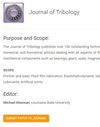基于响应面法的组合故障滚动轴承振动试验研究
IF 3
3区 工程技术
Q2 ENGINEERING, MECHANICAL
引用次数: 0
摘要
摘要本文提出了轴-转子-轴承组合中分布和局部多缺陷分析的经验和数学方法。对内滚道、外滚道和滚子组合的缺陷进行了测量分析。为了理解它们的相关性以及它们如何影响轴-转子-轴承机构的振动响应,速度、载荷和缺陷被认为是本研究中的关键过程因素。实验采用全析因法,实验采用实验设计(DOE)方法。振动响应试验的结果被量化为均方根(RMS)值,以便解释。为了确定工艺参数变化对振动响应的影响之间的关系,应用了响应面法(RSM)。用DOE对轴-转子-轴承试验装置进行了检验,用于勘探。在本研究中,建立了组合参数效应分析预测轴-转子-轴承系统故障的方法及其对DOE和RSM的影响。本文章由计算机程序翻译,如有差异,请以英文原文为准。
Experimental Vibration Investigation of Roller Element Bearing with Combined Faults using Response Surface Methodology
Abstract The empirical and mathematical approach is presented in the present paper for multiple distributed and localized flaws analyses in the shaft-rotor-bearing arrangement. These flaws in the combination of inner raceway, outer raceway, and roller are measured for the analysis. To comprehend their relevance and how they affect the vibration response for the shaft-rotor-bearing mechanism, speed, load, and flaws were regarded to be the crucial process factors in this investigation. The Full Factorial method was considered for experimentation, and the experiment was done with the design of experiments (DOE) methodology. The outcomes of the vibration response trials are quantified as Root Mean Square (RMS) values for interpretation. To determine the relationship between the effects of changing process parameters onto the response of vibrations, response surface methodology (RSM) is applied. DOE is used to examine the shaft-rotor-bearing test arrangement, which is employed for exploration. In the present research, it is established how combined parametric effect analysis predicts faults in the shaft-rotor-bearing system and how it affects DOE and RSM.
求助全文
通过发布文献求助,成功后即可免费获取论文全文。
去求助
来源期刊
CiteScore
4.20
自引率
12.00%
发文量
117
审稿时长
4.1 months
期刊介绍:
The Journal of Tribology publishes over 100 outstanding technical articles of permanent interest to the tribology community annually and attracts articles by tribologists from around the world. The journal features a mix of experimental, numerical, and theoretical articles dealing with all aspects of the field. In addition to being of interest to engineers and other scientists doing research in the field, the Journal is also of great importance to engineers who design or use mechanical components such as bearings, gears, seals, magnetic recording heads and disks, or prosthetic joints, or who are involved with manufacturing processes.
Scope: Friction and wear; Fluid film lubrication; Elastohydrodynamic lubrication; Surface properties and characterization; Contact mechanics; Magnetic recordings; Tribological systems; Seals; Bearing design and technology; Gears; Metalworking; Lubricants; Artificial joints

 求助内容:
求助内容: 应助结果提醒方式:
应助结果提醒方式:


